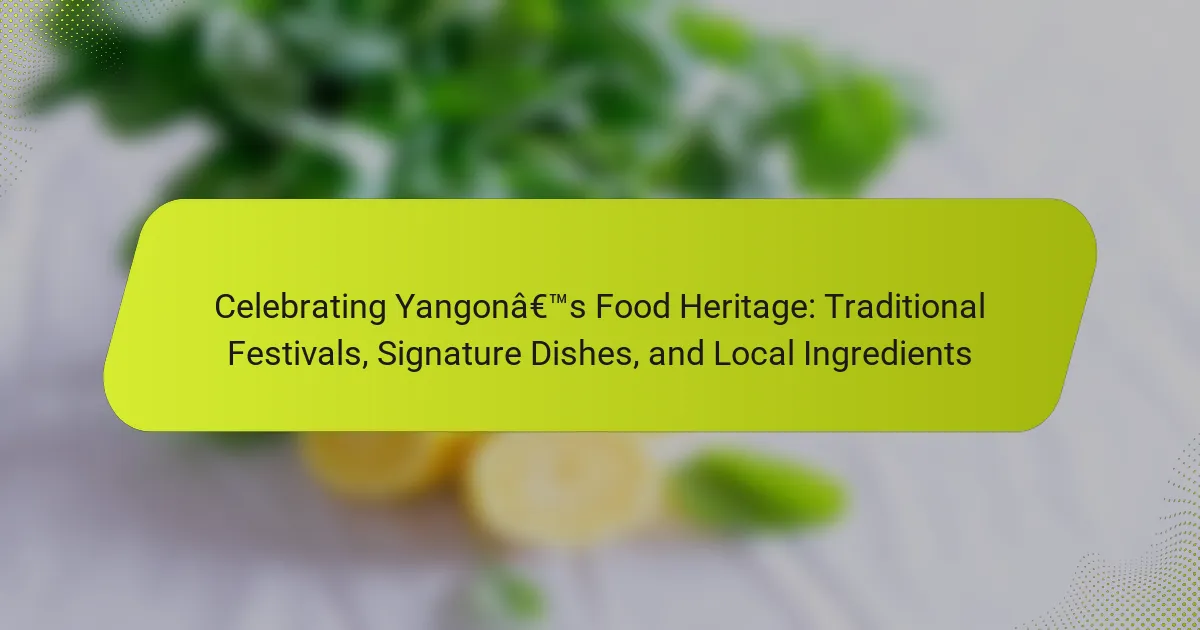Yangon’s food heritage encompasses a diverse array of flavors and culinary traditions influenced by Burmese, Chinese, Indian, and colonial British cuisines. Key signature dishes include Mohinga, a fish soup with rice noodles, Tea Leaf Salad, and Shan Noodles, all of which highlight the region’s rich culinary practices. Essential ingredients such as rice, fresh vegetables, and herbs are integral to local recipes, while traditional cooking methods like steaming and frying are commonly used. Festivals, including the Thingyan Water Festival, serve to celebrate and preserve this vibrant food culture, showcasing seasonal dishes that reflect the community’s agricultural practices and historical influences.

What is Yangon’s Food Heritage?
Yangon’s food heritage is a rich tapestry of flavors and traditions. It reflects the city’s diverse cultural influences, including Burmese, Chinese, Indian, and colonial British cuisines. Signature dishes such as Mohinga, a fish soup with rice noodles, exemplify local culinary practices. The use of fresh, local ingredients like fish, vegetables, and herbs is central to this heritage. Traditional cooking methods, such as steaming and frying, are commonly employed. Festivals and street markets play a vital role in preserving and showcasing this food culture. For instance, the Thingyan Water Festival features special dishes that highlight seasonal ingredients. Overall, Yangon’s food heritage is a vibrant expression of its history and community.
How has the history of Yangon influenced its food culture?
The history of Yangon has significantly shaped its food culture through diverse influences. Colonial rule introduced ingredients and cooking techniques from British, Indian, and Chinese cuisines. This resulted in the fusion of flavors and dishes unique to Yangon. The trade routes established in the past brought spices and other food items, enriching local culinary practices. Traditional Burmese dishes often incorporate these influences, showcasing the city’s multicultural heritage. Festivals in Yangon further highlight this diversity, as they celebrate various culinary traditions. The city’s historical context continues to play a vital role in the evolution of its food culture today.
What traditional practices are integral to Yangon’s culinary identity?
Yangon’s culinary identity is shaped by several traditional practices. One key practice is the use of local ingredients, emphasizing freshness and seasonality. Street food culture plays a significant role, with vendors offering dishes like mohinga and tea leaf salad. Communal dining is also integral, fostering a sense of community during meals. Festivals, such as Thingyan, showcase traditional dishes and cooking methods. Family recipes are often passed down through generations, preserving cultural heritage. The influence of ethnic diversity contributes to a rich tapestry of flavors and cooking styles. These practices collectively define the unique culinary landscape of Yangon.
How do historical events shape the local food scene?
Historical events significantly influence the local food scene by introducing new ingredients and culinary techniques. For instance, the British colonial period in Myanmar brought Indian and Chinese flavors to Yangon’s cuisine. This resulted in the creation of unique dishes like Mohinga, which blends local fish soup with spices from various cultures. Additionally, historical trade routes facilitated the exchange of spices and cooking methods, enriching local recipes. Events such as World War II also impacted food availability and preferences, leading to resourceful adaptations in cooking. Thus, the local food scene in Yangon reflects a tapestry of historical influences that shape its current culinary identity.
Why are traditional festivals important in celebrating food heritage?
Traditional festivals are important in celebrating food heritage because they preserve and showcase cultural culinary practices. These events provide a platform for communities to share traditional recipes and cooking methods. Festivals often feature local ingredients, emphasizing regional agricultural practices. They foster a sense of identity and belonging among participants. Celebrating food heritage through festivals helps pass down knowledge to younger generations. Historical records show that many traditional dishes are linked to specific festivals, reinforcing their cultural significance. For example, festivals often coincide with harvest seasons, highlighting seasonal foods. This connection strengthens community bonds and promotes local economies.
What are the key traditional festivals celebrated in Yangon?
Key traditional festivals celebrated in Yangon include Thingyan, Thadingyut, and Tazaungdaing. Thingyan marks the Burmese New Year and involves water festivities. It usually occurs in mid-April and lasts for several days. Thadingyut, the Festival of Lights, celebrates the end of Buddhist Lent. It takes place in October and features candle lighting and decorations. Tazaungdaing is known for its full moon celebrations in November. It includes the lighting of oil lamps and various cultural events. These festivals reflect the rich cultural heritage of Yangon. They also showcase local customs and community bonding.
How do these festivals showcase local culinary traditions?
These festivals showcase local culinary traditions by featuring traditional dishes unique to the region. They provide a platform for local chefs and home cooks to present their culinary skills. Attendees can taste a variety of signature dishes made from local ingredients. The festivals often include cooking demonstrations that highlight traditional preparation methods. Cultural performances further enhance the experience, linking food to local customs. Many festivals also incorporate competitions to celebrate the best local recipes. This encourages community participation and pride in culinary heritage. Overall, these events serve as a vibrant celebration of local food culture.

What are the signature dishes of Yangon?
The signature dishes of Yangon include Mohinga, Tea Leaf Salad, and Shan Noodles. Mohinga is a traditional fish soup served with rice noodles. It is often considered the national dish of Myanmar. Tea Leaf Salad, known as Lahpet, features fermented tea leaves mixed with nuts and spices. Shan Noodles are flat rice noodles served with chicken or pork and a flavorful broth. Each dish reflects the rich culinary heritage of the region. These dishes are commonly enjoyed by locals and visitors alike, showcasing the diverse flavors of Yangon.
What are the most popular dishes unique to Yangon?
The most popular dishes unique to Yangon include Mohinga, Tea Leaf Salad, and Shan Noodles. Mohinga is a traditional fish soup served with rice noodles. It is often considered the national dish of Myanmar. Tea Leaf Salad, known as Lahpet, features fermented tea leaves mixed with various ingredients. Shan Noodles are a rice noodle dish topped with chicken or pork and a flavorful sauce. These dishes reflect the culinary heritage of Yangon. They are commonly enjoyed by locals and visitors alike. Each dish showcases unique flavors and ingredients found in the region.
How are these dishes prepared and served?
Dishes in Yangon are prepared using traditional methods that highlight local ingredients. Common techniques include steaming, boiling, and frying. For example, Mohinga, a popular fish soup, is made by simmering fish broth with rice noodles and various spices. It is typically served hot, garnished with fresh herbs and lime. Another dish, Shan Noodles, involves boiling rice noodles and serving them with a flavorful sauce made of chicken or pork. These dishes are often accompanied by side condiments like pickled vegetables and chili paste. Presentation is essential, with dishes served in communal style for sharing. This approach fosters a sense of community during meals, reflecting the cultural heritage of Yangon.
What ingredients are essential for these signature dishes?
Essential ingredients for signature dishes in Yangon include rice, fish sauce, and various spices. Rice serves as a staple base for many meals. Fish sauce adds depth and umami flavor to dishes. Common spices include turmeric, ginger, and garlic, enhancing the overall taste. Fresh vegetables like lemongrass and coriander are frequently used for garnish and flavor. These ingredients are integral to the culinary identity of Yangon. They reflect local agricultural practices and cultural influences. Traditional dishes showcase the unique flavors of the region.
Why is it important to preserve traditional recipes?
Preserving traditional recipes is important for cultural heritage. These recipes embody the history and identity of communities. They reflect local ingredients, cooking methods, and customs. Traditional recipes foster a sense of belonging and continuity. They are often passed down through generations, maintaining family bonds. Additionally, preserving these recipes supports local economies by promoting indigenous food practices. Studies show that traditional diets contribute to better health outcomes. For instance, the Mediterranean diet, rooted in traditional recipes, is linked to lower rates of chronic diseases.
How do traditional recipes reflect cultural identity?
Traditional recipes reflect cultural identity by preserving historical and social narratives. They embody the values, customs, and beliefs of a community. Ingredients often signify local agriculture and climate, showcasing regional biodiversity. Cooking methods can indicate generational knowledge and techniques passed down through families. For example, specific spices may highlight trade routes and cultural exchanges. Additionally, traditional recipes often align with festivals and rituals, marking significant cultural events. The communal aspect of preparing and sharing these dishes fosters social bonds within the community. Overall, traditional recipes serve as a living testament to a culture’s heritage and identity.
What efforts are being made to keep these recipes alive?
Efforts to keep traditional recipes alive in Yangon include community cooking classes. These classes teach younger generations the techniques and ingredients used in local dishes. Cultural festivals also play a significant role in preserving culinary traditions. Events showcase traditional cooking methods and highlight signature dishes. Local chefs collaborate with elders to document recipes. This ensures authentic techniques are passed down. Additionally, social media campaigns promote awareness of these culinary heritages. Local markets emphasize the use of indigenous ingredients in recipes. These combined efforts help sustain and celebrate Yangon’s food heritage.

What local ingredients define Yangon’s cuisine?
Rice is a staple ingredient that defines Yangon’s cuisine. It is the primary carbohydrate source in many dishes. Fish sauce is commonly used to enhance flavors in various recipes. Fresh vegetables, such as long beans and eggplants, are frequently incorporated into meals. Herbs like cilantro and mint add freshness and aroma. Tamarind is utilized for its tangy taste in soups and sauces. Coconut milk is often used in curries, providing richness. These ingredients reflect the local agricultural practices and cultural influences in Yangon.
What are the key local ingredients used in Yangon’s signature dishes?
Key local ingredients in Yangon’s signature dishes include rice, fish sauce, and shrimp paste. Rice serves as a staple in many meals, often accompanied by various curries. Fish sauce adds depth to the flavor profiles of dishes like Mohinga, a traditional fish soup. Shrimp paste is integral in salads such as Lahpet, which features pickled tea leaves. Other notable ingredients are turmeric, garlic, and lemongrass, commonly used to enhance the taste of curries and soups. These ingredients reflect the rich culinary traditions and local agricultural practices of Myanmar.
How do these ingredients contribute to the flavor and authenticity of the dishes?
Ingredients significantly enhance the flavor and authenticity of dishes. They provide distinct tastes and aromas that define regional cuisines. For example, local spices like turmeric and ginger impart warmth and depth. Fresh herbs such as cilantro add brightness and freshness. Additionally, ingredients like fish sauce contribute umami, enriching the overall flavor profile. The use of traditional cooking methods with these ingredients ensures cultural authenticity. Historical practices and local sourcing of ingredients preserve culinary heritage. This connection to tradition reinforces the identity of the dishes served in Yangon.
Where can these local ingredients be sourced in Yangon?
Local ingredients in Yangon can be sourced from various markets and farms. Popular locations include the Bogyoke Aung San Market, known for fresh produce and spices. The Hledan Market offers a wide selection of local vegetables and fruits. Additionally, farmers’ markets in surrounding areas provide direct access to seasonal ingredients. Local grocery stores often stock regional products as well. These sources ensure a variety of fresh and authentic ingredients for traditional dishes.
How do seasonal ingredients influence the food heritage of Yangon?
Seasonal ingredients significantly influence the food heritage of Yangon. They dictate the availability and variety of dishes throughout the year. For instance, during the monsoon season, local markets feature ingredients like fresh bamboo shoots and various types of fish. These ingredients are integral to traditional recipes, such as mohinga, a popular fish soup. In contrast, the dry season brings an abundance of vegetables like pumpkin and gourds. These seasonal changes enrich the culinary landscape and reflect the agricultural practices of the region. Additionally, festivals often celebrate specific seasonal ingredients, reinforcing their cultural importance. This cycle of seasons and ingredients shapes the identity of Yangon’s food heritage.
What are the seasonal specialties that highlight local produce?
Seasonal specialties that highlight local produce include dishes made with ingredients that are harvested during specific times of the year. In Yangon, these specialties often feature fresh fruits, vegetables, and herbs. For example, during the monsoon season, dishes may include ripe mangoes and jackfruit. In the cooler months, local greens like mustard and watercress are prevalent in traditional recipes. The use of seasonal produce enhances flavor and nutritional value. These specialties reflect the agricultural cycles and cultural traditions in the region. Seasonal cooking promotes sustainability and supports local farmers.
How do local markets support the use of seasonal ingredients?
Local markets support the use of seasonal ingredients by providing direct access to fresh produce. They connect local farmers with consumers, ensuring that seasonal items are readily available. These markets often feature stalls dedicated to specific harvests. This promotes awareness of what is in season. Additionally, local markets encourage sustainable practices by reducing transportation distances. Many consumers prefer shopping at these markets for freshness and quality. In Yangon, local markets highlight traditional ingredients used in signature dishes. This fosters a culture of seasonal eating, benefiting both the community and the environment.
What practical tips can enhance the experience of exploring Yangon’s food heritage?
To enhance the experience of exploring Yangon’s food heritage, engage with local markets. Visiting markets like Bogyoke Aung San Market offers insight into local ingredients. Try street food stalls for authentic flavors. Dishes such as Mohinga and Shan noodles are local favorites. Participate in food tours to learn from knowledgeable guides. These tours often include tastings of signature dishes. Attend food festivals to experience traditional recipes and cultural significance. Research local dining etiquette to respect customs. Engaging with locals can provide personal stories about food traditions.
Yangon’s food heritage is a rich blend of culinary traditions influenced by Burmese, Chinese, Indian, and colonial British cuisines. The article explores the significance of traditional festivals in preserving this heritage, highlighting key events such as Thingyan and Thadingyut, which showcase local culinary practices and seasonal ingredients. Signature dishes like Mohinga, Tea Leaf Salad, and Shan Noodles are examined, along with the essential local ingredients that define Yangon’s cuisine. The discussion emphasizes the importance of preserving traditional recipes and the role of local markets in supporting seasonal eating, providing practical tips for exploring the vibrant food culture of Yangon.
